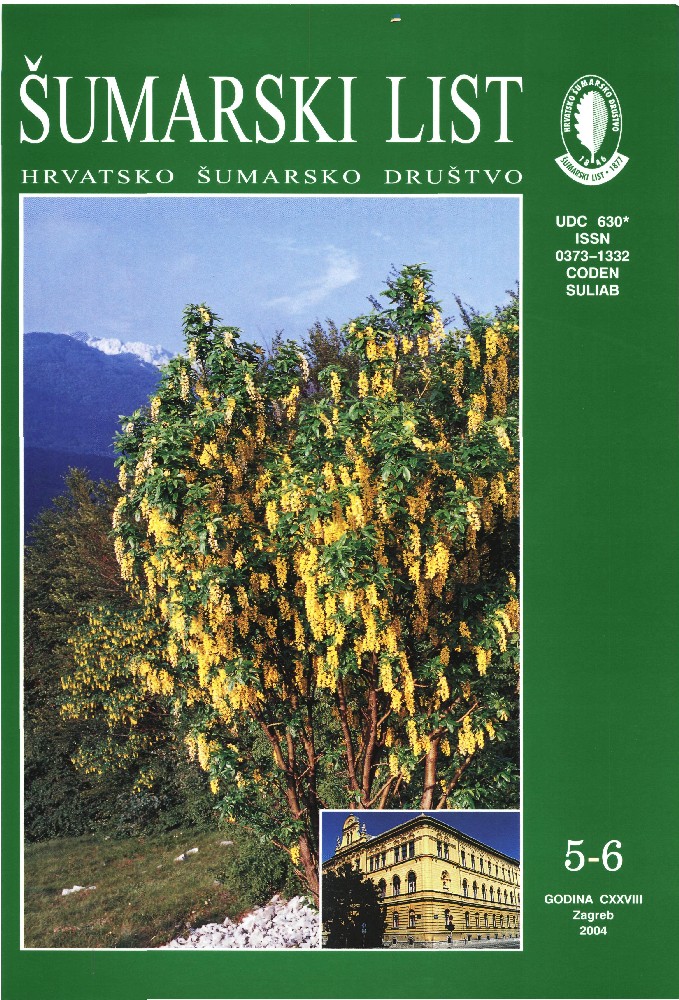
broj: 5-6/2004
pdf (38,8 MB) |
|
||||||||||||||
| IZVORNI ZNANSTVENI ČLANCI | ||
| Pernar, N., Vukelić, J., Bakšić, D., Baričević, D. | UDK 630* 114.4 + 188 | |
| An Insight Into Genesis and Properties of Soil in the Riparian Region of North-Eastern Baranja pdf HR EN | 223 | |
| Summary: Pedological and vegetational research into riparian forests of north-eastern Baranja was conducted during the summer of 2002. In each of the 12 locations defined by micro-relief and flora a pedological profile was opened in order to do morphological research and soil sampling for physical-chemical analyses.A total of six forest communities were identified in the study area: the purple willow thicket (Salicetum purpureae Wend.-Zel. 1952), the forest of almond willow (Salicetum triandrae Malc. 1929), the forest of white willow with bedstraw (Galio-Salicetum albae Rauš 1973), the forest of white willow and black poplar (Salici albae-Populetum nigrae Tx. 1931), the forest of white and black poplar (Populetum nigro-albae Slavn. 1952) and the forest of spreading elm and narrow-leaved ash (Fraxino-Ulmetum laevis Slav. 1952). The pedogenesis of the study area is characterised by distinct effects of the Danube hydrological regime. As a rule, the soil texture is of loamy to sandy character. Only in micro-relief depressions away from the riverbed (mostly in the surface part) may the texture be somewhat heavier (clayey loam to light clay). A characteristic feature of the soil in this region is a prominent texture stratigraphy. Apart from alluviation as a geological and pedogenetic process, these forest ecosystems are characterised by high organic production, which is sporadically significantly manifested in pedosphere humisation. The dominant soil type was found to be fluvisol, regularly carbonate, while gleysol and humofluvisol are represented to a much lesser degree. All these three soil types differ from one another in terms of ecological production. It should be pointed out that ecological-productive differences within one type are in some cases much larger than among the types, which is closely connected to the features of the water regime properties and the texture. From the aspect of pedotaxonomic nomenclature, in our view it is not necessary to classify some soils from the alluvial plain into a separate type. This refers to humofluvisols with a shallow A-horizon. An approach to the WRB classification seems to be a better solution, according to which the majority of such soils are classified into a group of fluvisols (except those with the A-horizon thicker than 25 cm). Key words: Baranja riparian forests; fluvisol; humofluvisol; pedophysiographic features | ||
| Krpan, A. P. B., Poršinsky, T. | UDK 630* 363 | |
| Efficiency of Mechanical Felling and Processing in Soft and Hardwood broadleaved stands – Part 2: Efficiency of harvesters in the culture of soft broadleaf trees pdf HR EN | 233 | |
| Zečić, Ž., Krpan, A. P. B., Poršinsky, T., Šušnjar, M. | UDK 630* 375 | |
| Efficiency of tractors 8090 and 9078 in shelterwood fellings of stands in Požega mountains pdf HR EN | 245 | |
| Pilaš, I., Potočić, N. | UDK 630* 561 + 116 | |
| Depedence of intraseasonal variations of tree stem diameter changes, electrical resistanee of cambial zone and groundwater in common oak stand (Q. robur L.) pdf HR EN | 255 | |
| Popijač, M., Seletković, I., Volner, M., Lovrenčić, I., Barišić, D., Kezić, N. | UDK 630* 160 + 161 | |
| Dynamics of 137Cs and 40K Movement in Silver fir Trees on Sljeme Mountain pdf HR EN | 269 | |
| Posavec, S. | UDK 630* 652 | |
| Specificy of Bussines Analyses Entities in Managing with Forest and Forest Land pdf HR EN | 279 | |
| Štorga, D. | UDK 630* 582 + 525 | |
| Application of GIS in Stand Extraction According to Dendrometric Parameters pdf HR EN | 287 | |


